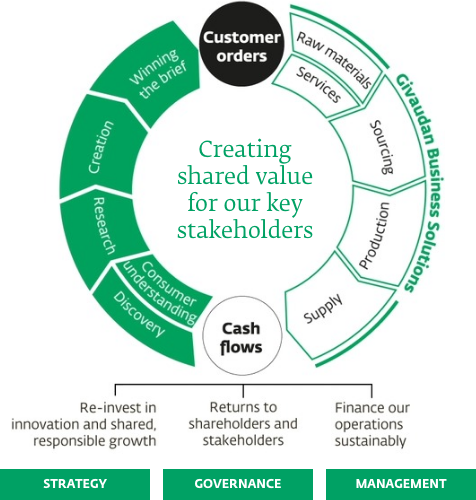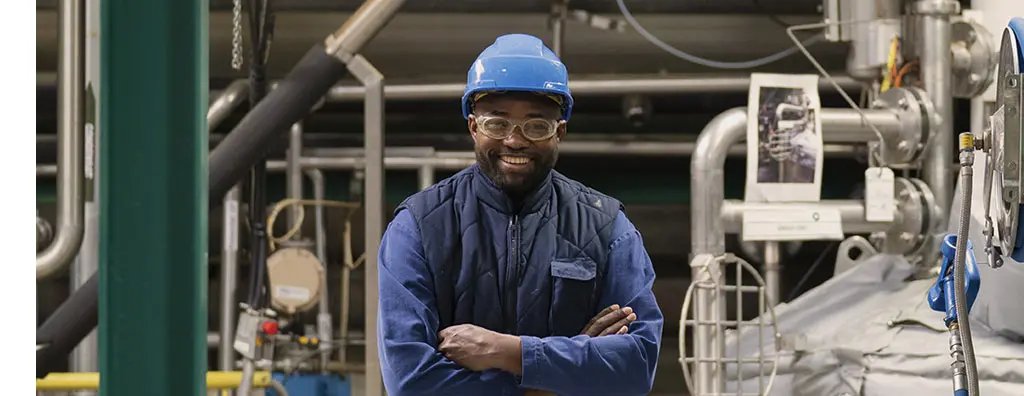
Our business model: creating sustainable value at Givaudan

Our value creation process shows how Givaudan draws on its various resources, called capital inputs, and translate them into outcomes – the internal and external consequences of our business activities that impact the Company and its stakeholders.
Our value creation process begins with resources called capital inputs.
We have identified six kinds of capitals that feed Givaudan’s value chain:
- Financial capital
- Intellectual capital
- Human capital
- Natural capital
- Manufactured capital
- Social and relationship capital
Together, these inputs feed directly into our business model.

Financial capital
Funds available to the Group
- A– S&P, Baa1 Moody’s Investment Grade Credit Rating
- CHF million 4,578 of equity

Intellectual capital
Technology, patents, know-how, processes
- 62 creation and research centres
- CHF million 565 R&D spend

Human capital
The skills, motivation, diversity of our people, best-in-class health and safety procedures
- > 16,900 total full-time employees
- 32% women in senior leadership positions

Natural capital
Raw materials, indirect materials and services, innovative sourcing models
- > 11,000 different raw materials sourced
- 114 countries of sourcing

Operations capital
Production sites, infrastructure, end-to-end supply chain solutions
- 78 production sites supporting our customers’ growth globally
- 3-4% of sales invested annually in Capex

Social and
relationship capital
relationship capital
Our relationships with local communities, regulators and industry bodies, brand and reputation
- >18,000 suppliers
- CHF 100,000 donation through humanitarian fund
Our business model
How we operate
- Our customers are at the heart of our strategy
- Innovation and sustainability drive growth and value
- Strongly focused on protecting and supporting our employees
- Our two divisions, Taste & Wellbeing and Fragrance & Beauty, are aligned with the value chain and address customer needs with differentiated solutions and business strategies
- Addressing ESG topics through our purpose and strategy
Our value chain
Through our value chain we create innovative products and solutions that have a positive impact on nature, people and communities. The corresponding outputs and impacts deliver growth – in partnership with our customers – through creating inspiring products for happier, healthier lives.

Our business model uses these capital inputs for the realisation of our business activities. Taste & Wellbeing, and Fragrance & Beauty, aim to shape the future of food, fragrances and beauty by becoming the innovation and co-creation partner of choice to our customers.

Financial capital
Responsible financial growth and shared profitability
- CHF million 7,412 sales
- 24.5% comparable EBITDA

Intellectual capital
Differentiating solutions through responsible innovation
- ~ 5,000 active patents worldwide
- 2 digital factories: in Paris, France and Shanghai, China

Human capital
Recruiting, developing and caring for diverse and inclusive workforce
- 673 human rights and business trainings completed by employees
- –34% total recordable case rate since 2018

Natural capital
Reducing water and energy consumption, emissions and waste, preserving biodiversity and renewable resources
- –48% GHG reduction scope 1+2
- –27% water withdrawal rate for sites located in areas facing water stress since 2020

Operations capital
New site openings and sustainable products produced and sold
- 128,400 products sold
- 6 announcements of production facilities, lab space, ingredients facilities and Creative Centres in: China, Mexico, Indonesia, Turkey and Poland

Social and
relationship capital
relationship capital
Stakeholder engagement and collective action
- 100% of our production sites are registered on Sedex
- ~ 626,500 people benefited through community initiatives
As a purpose-led Company, our value creation process helps us deliver growth in partnership with our customers and increases our positive impact on nature, people and communities by creating inspiring products for happier, healthier lives.
It enables us to deliver success to our customers and our stakeholders while shaping a better tomorrow for all. Stakeholders that benefit are:
• Customers
• Suppliers
• Employees
• Owners and investors
• Local communities
• Public and regulatory agencies
Environmental
+ Impacts
- Contribute to climate action and resilience
- Contribute to the preservation and restoration of biodiversity
- Conserve resources, avoid unrecycled waste and strengthen circularity
- Increase access to more sustainable products
– Impacts
- Emission of CO2 and other gases that affect the climate
- Risk of land-use change
- Water use in water-stressed areas
- Waste directed to disposal
Our mitigation measures
- Climate transition plan
- Biodiversity programmes
- Sustainable energy and water management
- Circularity principles
Social
+ Impacts
- Prioritise safety and encourage a culture of care
- Provide attractive jobs and promote diversity
- Pay competitive wages and salaries
- Improve mental and physical health
- Improve livelihoods of farmers, workers and wider communities in areas where we source
– Impacts
- Workplace safety and health issues
- Personal adjustments
- Potential risk of deviation or violation of labour, environmental and social standards
Our mitigation measures
- Inclusive health and safety programmes
- Compliance programme, code of conduct
- Projects to improve environmental and social impact in the supply chains
- Selection and evaluation of suppliers
Economic
+ Impacts
- Drive inclusive and economic growth
- Provide higher incomes and better standards or living
- Offer investors an attractive dividend yield
- Contribute to a fair share of tax contributions where we operate
– Impacts
- Slowdown in growth due to the uncertain macro economic and geopolitical environment
- Slowdown due to supply chain disruption impacting operations
- Weakening of performance from rising interest rates and foreign currency volatility
Our mitigation measures
- Naturally hedged business (portfolio, geography, customers)
- Systematic cost management
- Programme of continuous improvement
- Automation and leveraging technology
- Strong governance and risk management




